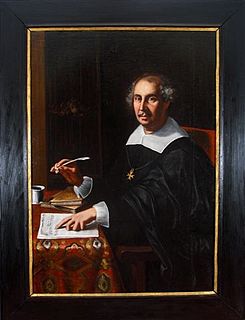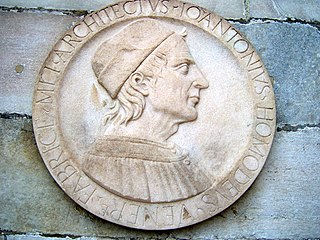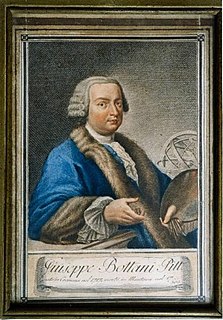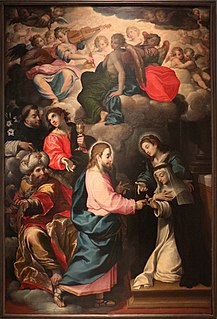Related Research Articles

Tarquinio Merula was an Italian composer, organist, and violinist of the early Baroque era. Although mainly active in Cremona, stylistically he was a member of the Venetian school. He was one of the most progressive Italian composers of the early 17th century, especially in applying newly developed techniques to sacred music.

Giovanni Antonio Amadeo was an Italian early Renaissance sculptor, architect, and engineer.

Benedetto Briosco (c.1460–c.1517) was an Italian Renaissance sculptor and architect, active in Lombardy.

Bonifacio Bembo, also called Bonfazio Bembo, or simply just Bembo, was a north Italian Renaissance artist born in Brescia in 1420. He was the son of Giovanni Bembo, an active painter during his time. As a painter, Bonifacio mainly worked in Cremona. He was patronized by the Sforza family and was commissioned to paint portraits of Francesco Sforza and his wife Bianca Maria Visconti. He is also attributed with producing a tarot card deck for the Visconti-Sforza families. In the past century, art historians have begun to question the authenticity of his works, believing his only two secure works to be the portraits of Francesco and Bianca Maria Sforza. He is believed to have died sometime before 1482.
Sebastiano Bombelli was an Italian painter, mainly active in Venice, during the Baroque period.
Francesco Aureri was an Italian sculptor of the Renaissance period, active in Cremona.

Domenico Auria was an Italian architect and sculptor of the Renaissance period, active in Naples. He was a pupil of Marliano da Nola. He is also known as Giovanni Domenico or Giovan Domenico Auria, or Domenico d'Auria.

Giovanni Giacomo Barbelli was an Italian painter of the Baroque period, active in Lombardy. He was a canvas and fresco painter known for his religious and mythological scenes that decorate many churches and residences in Lombardy. He was a highly skilled draughtsman and a brilliant colorist. His work shows an inventive imagination and a thorough knowledge of perspective.
Francesco Bassi was an Italian painter active in the early-Baroque period, mainly in his hometown of Cremona, but also in Venice. He was also known as Francesco Maria Bassi the elder.
Antonio Beduschi was an Italian painter active in the early-Baroque period, mainly in his hometown of Cremona. He imitated the style of Antonio Campi. His sister, Angela Beduschi, was also a painter. In 1602, he painted the Martyrdom of St. Stephen and a Pietà for the church of San Sepolcro in Piacenza.

Marco Bello was an Italian painter active in the Renaissance period. He was one of the pupils in the studio of Giovanni Bellini.
Antonio Beltrami (1724–1784) was an Italian painter active in the late-Baroque and Neoclassic periods. He was born in Cremona. He was a pupil of Francesco Boccaccino, who emerged from the school of Carlo Maratta. His older brother, Giovanni Battista was an engraver.

Giuseppe Bottani was an Italian painter active in the Baroque period.
Sigismondo Benini was an Italian painter of the Baroque period, active in Lombardy, painting landscapes or vedute. He was born in Cremona, and trained with Angelo Massarotti. His son Giuseppe Benini also painted landscapes. His grandson Luigi Benini, died at age 34 years. He had studied in Rome and returned to Cremona in 1790.

Francesco Brenti was an Italian painter of the Mannerist style, active in Cremona 1612–1620. He appears to have trained with Giovanni Battista Trotti.
Giovanni Battista Natali was an Italian painter of the late-Baroque period, active in his natal city of Piacenza, but also Savona, Lucca, and Naples, and finally Genoa in 1736.

Alessandro Capra was an Italian architect and inventor. He was born in Cremona.
Tomasso Amici was an Italian sculptor active in Cremona in the late 15th century. He worked in the style of the thirteenth-century sculptor Bramanto Sacchi. He is known for having sculpted the reliefs in altar of St Nicolas (1495) in a Gothic style in the Duomo di Cremona, where he worked with Fra Mabila de Mazo.

Cristoforo Agosta or Agosti or Augusta was an Italian painter of the Mannerist style.
Carlo Natali, also known as il Guardolino, was an Italian painter of the Baroque period, active in Cremona and Bologna
References
- Ticozzi, Stefano (1830). Dizionario degli architetti, scultori, pittori, intagliatori in rame ed in pietra, coniatori di medaglie, musaicisti, niellatori, intarsiatori d’ogni etá e d’ogni nazione' (Volume 1). Milan: Gaetano Schiepatti. p. 208.